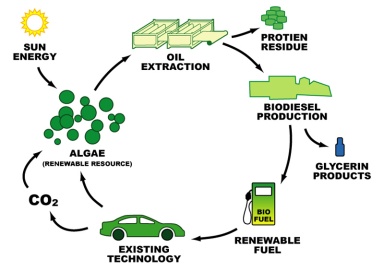สาหร่ายน้ำมัน โดยปัจจุบันพบว่ามีสายพันธุ์ที่เหมาะสมกับสภาพแวดล้อมของไทยแล้วกว่า 40 สายพันธุ์ และจากการศึกษาเบื้องต้นพบว่า ต้นทุนของน้ำมันจากสาหร่ายน้อยกว่า 150 ดอลลาร์ต่อบาร์เรล และสาหร่ายมีผลผลิตสูงกว่า 30 กรัมต่อตารางเมตรต่อวัน และมีปริมาณน้ำมันประมาณ 40% หรือสามารถคิดเป็นผลผลิตน้ำมันสาหร่ายประมาณ 6 ตันน้ำมันต่อไร่ต่อปี ไม่รวมผลิตภัณฑ์พลอยได้ จำพวกโปรตีนคุณภาพสูง และสารสกัดจำพวกกรดไขมันที่จำเป็นต่อร่างกาย...พลังงานทางเลือก ไบโอฟิวส์ สกัดน้ำมันออกมาจากพืชอย่างข้าวโพด/ถั่ว/มันสำปะหลัง/อ้อย นั้นเป็นการใช้พืชอาหารมาทำพลังงานทดแทนที่ส่งผลทำให้ราคาสินค้าเกษตรมีราคาสูงขึ้นหรือจะเกิดการแย่งชิงทรัพยากรหรือไม่ การใช้ "สาหร่ายน้ำมัน" จึงกลายเป็นวิวัฒนาการการผลิตเชื้อเพลิงทางเลือก ที่จะช่วยลดกระทบกับราคาสินค้าเกษตรอีกด้วย









Theyve proven the concept, he says, and algae has a place in carbon capture across the industrial world, including at Fischer-Tropsch fuel production facilities
for coal-to-liquids or gas-to-liquids, which are among the worlds most potent producers of CO². Natural gas-fired power plants in the U.S. are also feeding
algae.
The environmental advantages of algae which absorb CO2 along with nitrates and phosphates are coupled with the promise of commercial yields of high
quality biofuel.
Bill Gates and his Cascade Investment LLC jumped behind Sapphire Energy of San Diego, helping them raise substantially more than $100 million by
September, along with ARCH Venture Partners, Wellcome Trust and Venrock. Sapphire means to produce 10,000 barrels of green crude in three to five years.
Among the oldest players is Ingrepro Micro Ingredients, and director C. Callenbach says theyre competitive today. If oil doesnt go below $42/barrel, then it
gets into the break-even, he asserts. This year the company is building four energy farms a combination of wastewater treatment and algae plant. You
produce biomethane and at the same time you produce biomass, he says, adding: On 30 hectares the low cost we can achieve is 7080 tonnes per hectare.
Credit : //www.renewableenergyworld.com/rea/news/article/2009/06/blooming-biofuel-how-algae-could-provide-the-solution
เทคนิคการเพาะเลี้ยงสาหร่ายอาหารเมืองร้อนทีประสบผลสำเร็จแล้ว
Cultivation of Spirulina
In tropical countries Spirulina cultured under authotrophic, heterotrphic and mixotrophic conditions..........Some of the algae like Chloralla,
Soenedesmus, Coelastrum and Spirulina have been found to suitable for mass cultivation and utilization. The advantages in using algae include simple cultivation, effective utilization of solar energy, faster growth and high protein and nutrient content.


The optimum temperature for Spirulina is the temperatures in between 25 and 35°C.
The growth will be retarded when the temperatures below 20°C.
Although Spirulina seems to be a more thermophilic alga, it could not withstand longer periods at temperatures above 40°C.
Light intensities of 30-40 klux were found to be optimal for Spirulina.
To maintain these intensities during summer months, scaffoldings were arranged around the ponds and roofed over sparsely with coconut fronds, which cut down the light by 40-50%, but left enough space for ventilation
Credit : //biomaster2011.blogspot.com/2011/03/single-cell-protein-from-spirulina.html





CREDIT: //solazyme.com
อ่านเพิ่มเติม:
//www.ises.org.il/assets/files/Conference%202011/Ben-Amotz%20ISES2011.pdf